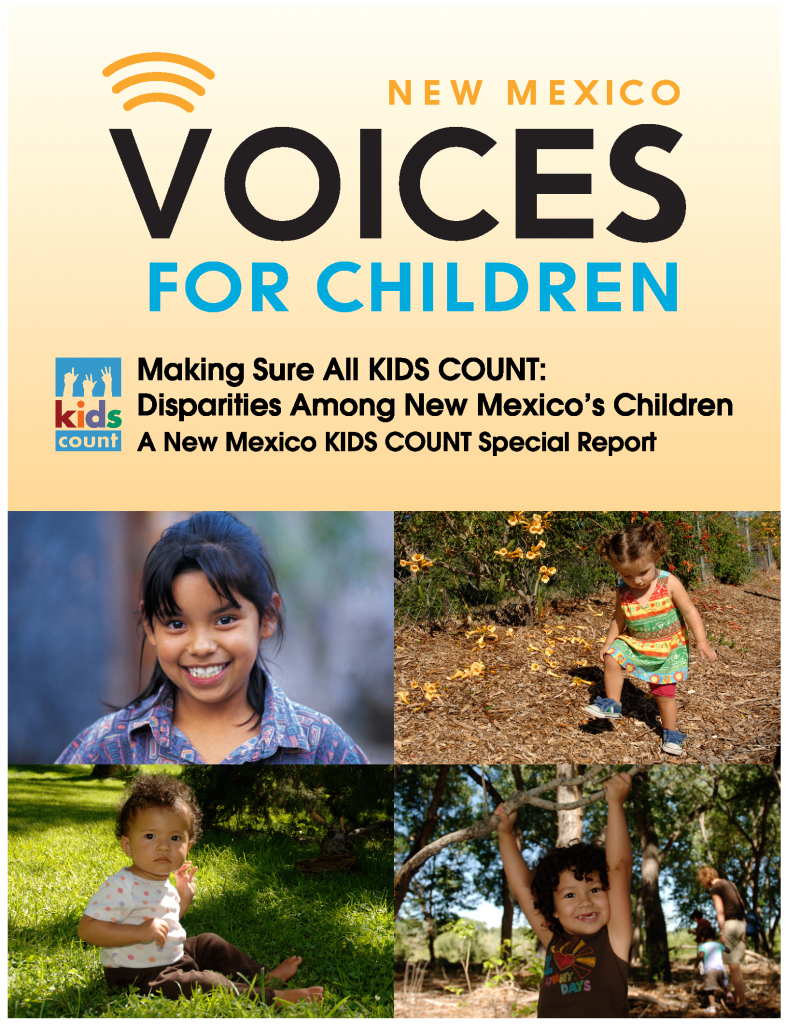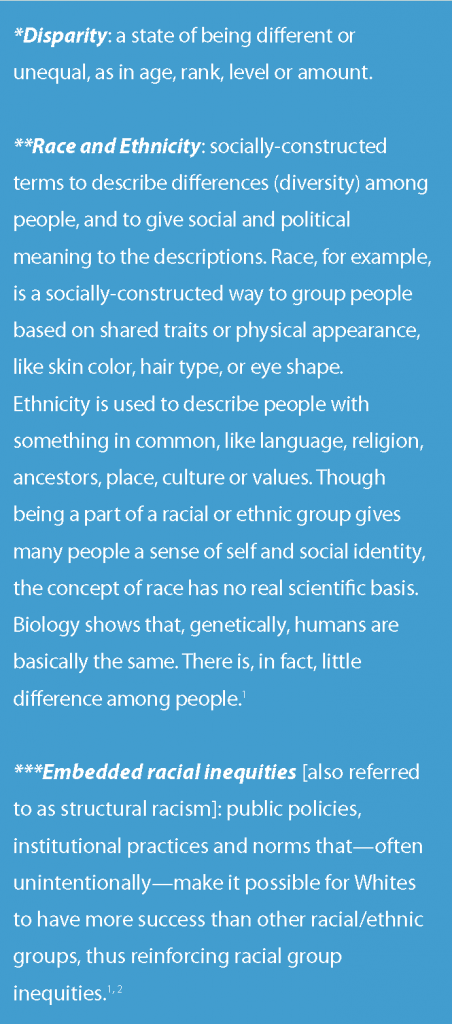 A New Mexico KIDS COUNT Special Report
A New Mexico KIDS COUNT Special Report
Download the full report (Dec. 2010; 22 pages; pdf)
Link to the second report in this series, Race, Ethnicity, and Economic Outcomes in New Mexico (May 2011)
Download the second report in this series, Race, Ethnicity, and Economic Outcomes in New Mexico (14 pages; pdf)
In many ways New Mexico is a great place to raise children. It is rich with cultural traditions and its physical beauty and diverse geography lends itself toward a healthy, outdoors-loving lifestyle. Education is heavily supported by the state—rather than being dependent on local taxes—receiving about $2 out of every $5 of the General Fund budget on kindergarten (K) through grade 12 learning. The state also supports child public health efforts like immunization.
Yet New Mexico has fallen short—for more than 20 years—in ensuring that its children and their families have access to the supports they need in order to thrive. The 2010 KIDS COUNT Data Book ranked only four other states worse than New Mexico in how poorly children are doing. First, New Mexico must take steps to improve life for its children and promote their future success if the state is to have future success. Much research tells us the following key things can help achieve this.
We must make sure children:
- get a good start in life—even before birth with access to prenatal care, support and resources for caregivers, safe places to live, good health care and food, and first-rate child care;
- get first-class early childhood learning or preschool programs to prepare them for school; and
- learn to read by the 4th grade in small-size classrooms led by trained, well-paid teachers.
We know that early school success helps kids finish high school and go to college. Youth who succeed in and graduate from school tend to get stable job that pay well, and are less apt to live in poverty, be teen parents, or to become criminals. All New Mexico’s children, no matter their income, status, race or ethnic background, culture or geography, do better when they have stable families, live in caring communities, get a good education, and have good health care.
Purpose of this Report
This 2010 New Mexico KIDS COUNT special report is the first in a series to come that will document and explain the barriers keeping some children in the state from doing as well as others. These reports will also describe positive policies and programs that effectively help all children and families—but especially those who face social and economic inequities—and that could be implemented in this state. New Mexico is proud of its diverse peoples; for this reason, we present data by race and ethnic background to show how well, or not, all children in the state are doing—in health, living conditions, education, and other aspects of well-being. This introductory report also suggests certain broad steps that can be taken to improve life for all of New Mexico’s children.
Setting the Context: Some Basic Language
New Mexico KIDS COUNT (NM KIDS COUNT) collects and reports on the most comprehensive health, economic, educational and demographic data available to show how children and families are doing in the state. These reliable data indicate where barriers exist that keep children from doing well and where gaps in well-being exist among different child populations. We use these data to design and promote state and local policies, programs and opportunities that support all families, especially when they face disparities* and/or go through tough times.
Our state’s population is increasingly diverse, and people’s lives are shaped by various factors—like where they live, work, learn and play, what resources they have, the people around them, and their history and race or ethnicity.** Where one starts in life—in a poor or well-to-do family, in a safe or unsafe neighborhood, with or without access to health care and fine schools—tends to strongly affect the kind of life one will have. For these reasons, NM KIDS COUNT is making a conscious effort—in all its publications and work—to increase the amount and type of data broken down by income, race and ethnicity, and geography to better show where barriers to well-being exist for children. It is useful to break down data by such constructs as race and ethnicity so we can see how different groups of people compare on a measure, like health status. This helps us to identify a disparity or inequity that is particularly pronounced in one or more groups. Identifying the disparity is just the first step—we must also determine what the causal factors are before we can consider how to address it. Decision-makers can then develop policies to better solve the underlying issue and promote equity for all. This introductory report sets the context and is the first in a series that will document the barriers some children face that make it more difficult for them to do as well as others and recommend policy and programmatic solutions.
The NM KIDS COUNT program is most concerned with barriers to child well-being that are considered to be embedded racial inequities.***
An example was the design of the G.I. Bill after World War II that provided low-interest mortgages and down payment waivers for returning servicemen who wanted to buy homes for their families. Though considered an equal opportunity benefit, restrictive lending practices at the time favoring Whites meant that more White families could purchase homes in new suburban neighborhoods than could Black, Hispanic, Native American or Asian servicemen. Because of this inequitable access to the mortgage benefit, this meant that over the long-term, White homeowners were better able to begin building wealth. Today, White families continue to have greater wealth (resource) accumulation than do communities of color.3
As much as possible, this special report presents racial and ethnic data using the U.S. Census Bureau classifications. Given this, races include: White, American Indian/Alaskan Native (we will use the term Native American), African American/Black (we will use the term Black), Asian, Native Hawaiian and other Pacific Islander, “two or more races,” and “other race alone.” The U.S. Census considers the Hispanic (or Latino) origin an “ethnicity,” not a race. Since people in each race group may also be Hispanic (such as a White-Hispanic or Black-Hispanic), this report presents most data by the following categories: Hispanic (only), White (non-Hispanic), Black (non- Hispanic), Native American (non-Hispanic), Asian (non-Hispanic), two or more races, and other race alone.4 In most cases, data for New Mexico are only presented for the following, larger populations: Hispanic, Black, Native American, and White.
Endnotes
1. Institute of Medicine of the National Academies. (2002) Speaking of Health: Assessing Health Communication Strategies for Diverse Populations. Washington, D.C.: National Academies Press.
2. Aspen Institute Roundtable on Community Change. (June 2004). Structural Racism and Community Building. Washington, D.C.: The Aspen Institute.
3. Annie E. Casey Foundation. Race Matters: User’s Guide. Retrieved September 1, 2010 from: http://www.aecf.org/KnowledgeCenter/PublicationsSeries/RaceMatters.aspx
4. Grieco, E. & Cassidy, R. (March 2001). Overview of Race and Hispanic Origin: Census 2000 Brief. Washington, D.C.: U.S. Census Bureau.
Download the full report (Dec. 2010; 22 pages; pdf)
Link to the second report in this series, Race, Ethnicity, and Economic Outcomes in New Mexico (May 2011)
Download the second report in this series, Race, Ethnicity, and Economic Outcomes in New Mexico (14 pages; pdf)
Find more data for New Mexico and the nation here
NM KIDS COUNT is a program of the Annie E. Casey Foundation.


